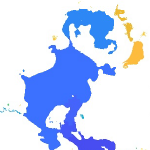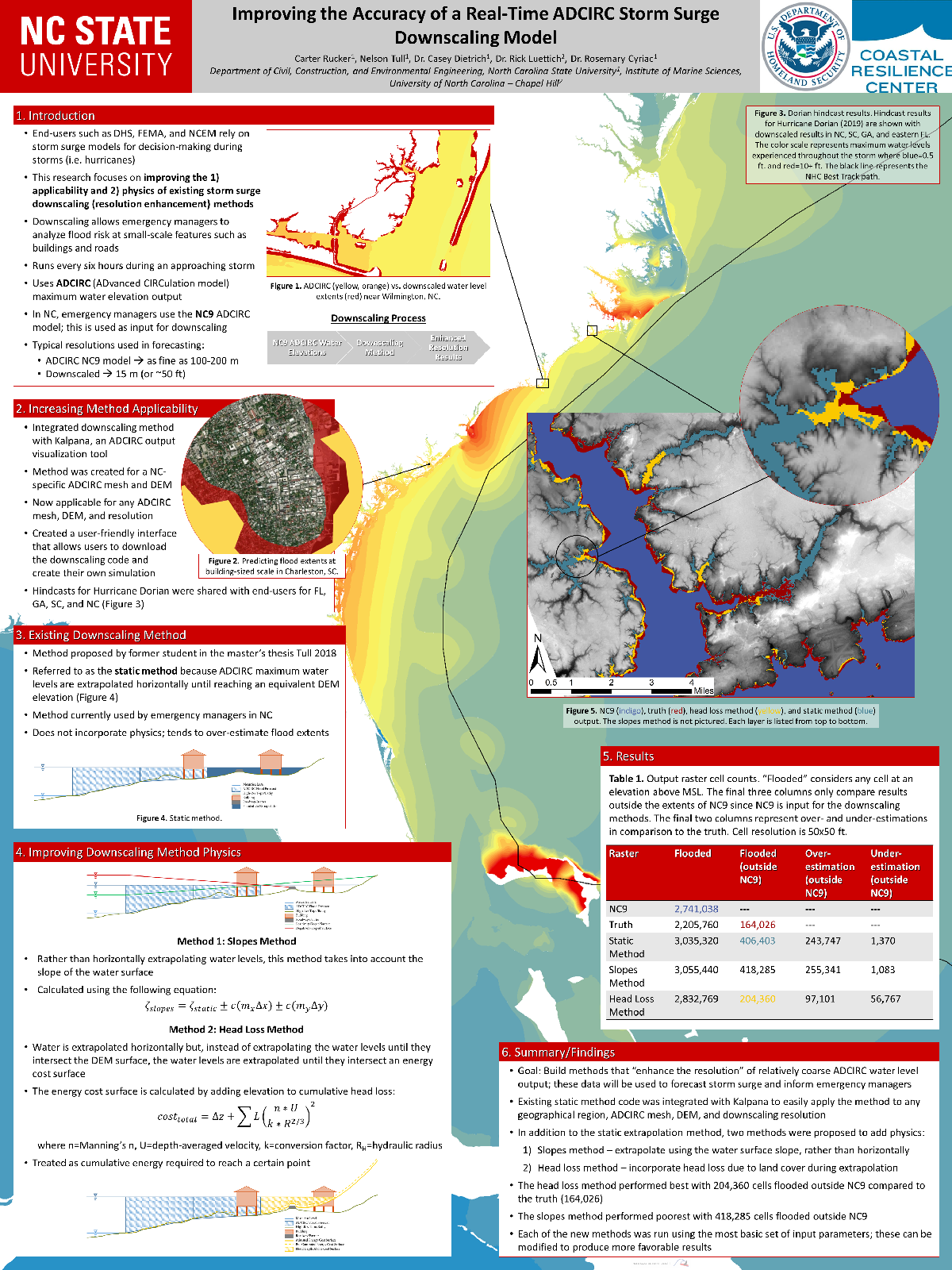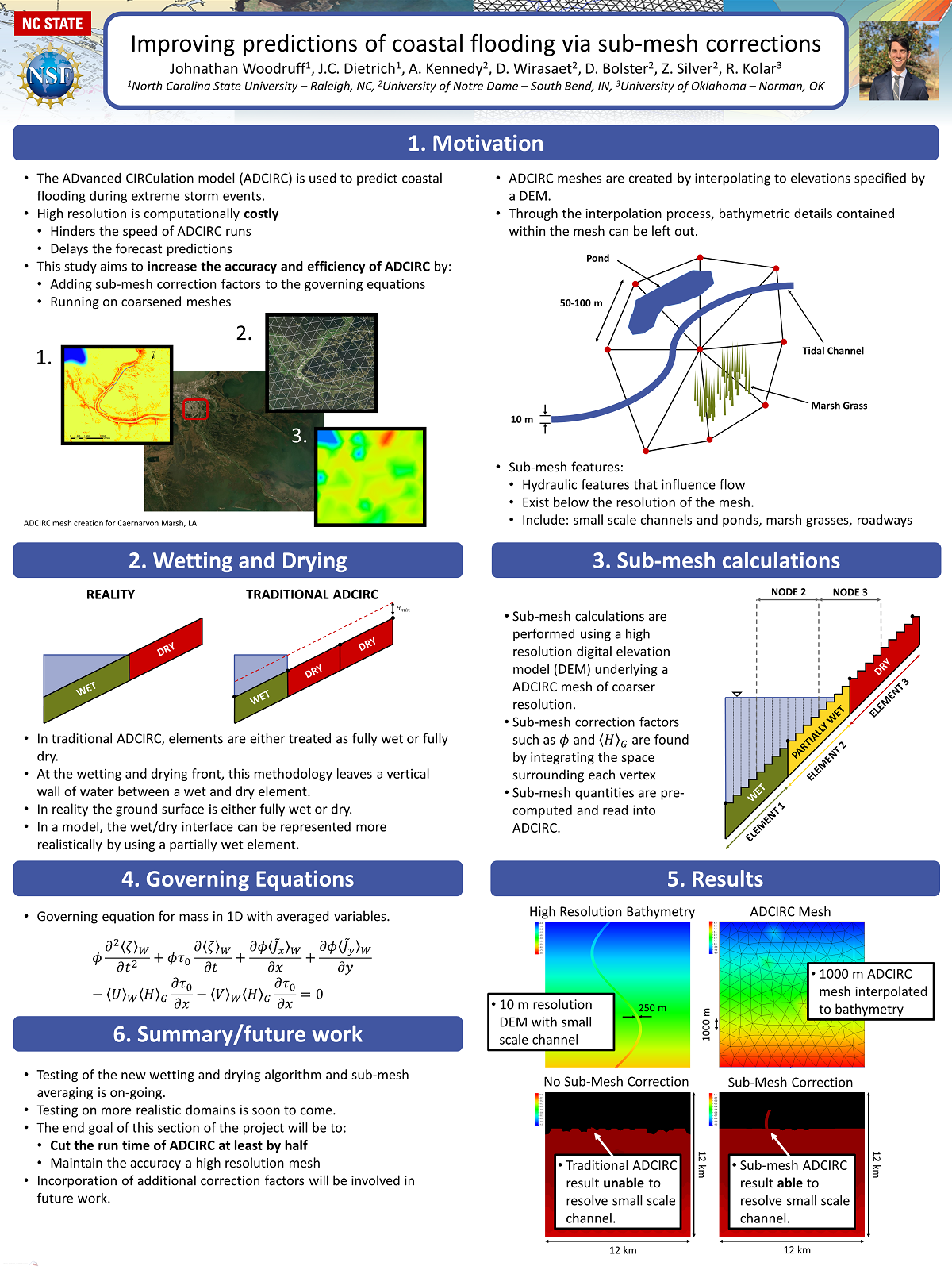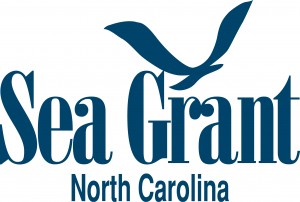Posters: EWC Symposium 2020
CA Rucker, N Tull, JC Dietrich, R Luettich, R Cyriac. “Improving the accuracy of a real-time ADCIRC storm surge downscaling model.” Environmental, Water Resources, and Coastal Engineering Research Symposium , North Carolina State University, 6 March 2020.
JL Woodruff, JC Dietrich, AB Kennedy, D Wirasaet, D Bolster, Z Silver, RL Kolar. “Improving predictions of coastal flooding via sub-mesh corrections.” Environmental, Water Resources, and Coastal Engineering Research Symposium, North Carolina State University, 6 March 2020.
Wind and Tide Effects on the Choctawhatchee Bay Plume and Implications for Surface Transport at Destin Inlet
 Multiple river-dominated estuaries line the northern Gulf coast and introduce substantial density variations. Their plumes have been shown to be highly sensitive to wind and tide effects, but in studies with limited observations and idealized wind forcing. This study explores these effects with a dynamic model that can represent the full behavior from river through estuary to shelf, and for a period with extensive observations. The inner shelf adjacent to Choctawhatchee Bay, a micro tidal estuary situated along the Florida Panhandle, is subject to buoyant, brackish outflows during the ebb-phase of the tidal cycle.
Multiple river-dominated estuaries line the northern Gulf coast and introduce substantial density variations. Their plumes have been shown to be highly sensitive to wind and tide effects, but in studies with limited observations and idealized wind forcing. This study explores these effects with a dynamic model that can represent the full behavior from river through estuary to shelf, and for a period with extensive observations. The inner shelf adjacent to Choctawhatchee Bay, a micro tidal estuary situated along the Florida Panhandle, is subject to buoyant, brackish outflows during the ebb-phase of the tidal cycle.
In December 2013, experiments were performed in this region to study mechanisms that influence near-shore surface transport. Satellite imagery showed a visible brackish surface plume at Destin during low tide. The goal of the present study is to quantify variability in the plume signature due to changes in tidal and wind forcing. Density-driven flows near Destin Inlet are modeled with the recently-enhanced, three-dimensional, baroclinic capabilities of the ADvanced CIRCulation (ADCIRC) model. Modeled tides, salinities and plume signature are validated against in-situ observations and satellite imagery. Model results reveal substantial changes in the length, width and orientation of the plume as the wind direction varied on consecutive days due to winter cold fronts. During a period of near-constant winds and variability in tidal amplitude, the model predicted a larger plume during spring tides than during neap conditions. Coriolis effects on the plume are minimized due to its small scale nature. Therefore, when the wind forcing is weak, the plume signature spreads radially from the inlet with slight preference to the down-shelf. The Choctawhatchee Bay plume is representative of other small-scale plumes formed in river-dominated and micro-tidal environments, and this work demonstrates the sensitivity of these plumes to changing environmental conditions.
Improving Predictions of Estuarine Flooding and Circulation during Storms
The research plan will have two components. First, the existing modeling system will be enhanced for the NC estuaries, and numerical experiments will explore the sensitivities of estuarine flooding to the main drivers during storms. By varying systematically the atmospheric forcing, bottom friction, incoming river flows, and other parameters, we will improve our understanding of how storm surge is developed in these regions. Second, the modeling system will be extended to consider density-driven circulation and salinity transport, by leveraging earlier work for estuarine circulation in the northern Gulf. It is known that horizontal salinity transport during storms can threaten marine life and vegetation, but there is not currently a modeling system that can predict both transport and overland flooding. This project will combine those processes and explore questions about stratification during storms. While these interactions are important in estuaries along the U.S. Gulf and Atlantic coasts, they are especially important for the NC estuaries and their nearby communities, which have been devastated by storms in recent years.
The project will also have an extensive education component. Via collaboration with the Coastal Studies Institute, we will develop and implement lesson plans for storm surge and coastal flooding. It is expected that this new program will engage with more than 300 students in northeastern NC. The research team is well-positioned to contribute to these outreach activities, thus benefiting coastal communities in NC.
JC Dietrich, RJ McCord. “Improving Predictions of Estuarine Flooding and Circulation during Storms.” National Oceanic and Atmospheric Administration, North Carolina Sea Grant, 2020/02/01 to 2022/01/31, $119,370 (Dietrich: $99,610).
News: CCHT Leads a Core Research Project for NC Sea Grant
NC Sea Grant Announces 2020–2022 Core Research Projects
North Carolina Sea Grant’s core research projects for 2020 to 2022 will apply innovative approaches to coastal issues. Research teams across the state are starting new studies on coastal resilience, climate change, flooding, shellfish and aquaculture, environmental literacy and more.
“Our core research examines real-world needs of our coastal communities and ecosystems,” says Susan White, executive director of North Carolina Sea Grant. “We are pleased to have so many multidisciplinary collaborations that address our program’s strategic focus areas.”
Subgrid Theory for Storm Surge Modelling
 Averaging techniques are used to generate upscaled forms of the shallow water equations for storm surge including subgrid corrections. These systems are structurally similar to the standard shallow water equations but have additional terms related to integral properties of the fine-scale bathymetry, topography, and flow. As the system only operates with coarse-scale variables (such as averaged fluid velocity) relating to flow, these fine-scale integrals require closures to relate them to the coarsened variables. Closures with different levels of complexity are identified and tested for accuracy against high resolution solutions of the standard shallow water equations. Results show that, for coarse grids in complex geometries, inclusion of subgrid closure terms greatly improves model accuracy when compared to standard solutions, and will thereby enable new classes of storm surge models.
Averaging techniques are used to generate upscaled forms of the shallow water equations for storm surge including subgrid corrections. These systems are structurally similar to the standard shallow water equations but have additional terms related to integral properties of the fine-scale bathymetry, topography, and flow. As the system only operates with coarse-scale variables (such as averaged fluid velocity) relating to flow, these fine-scale integrals require closures to relate them to the coarsened variables. Closures with different levels of complexity are identified and tested for accuracy against high resolution solutions of the standard shallow water equations. Results show that, for coarse grids in complex geometries, inclusion of subgrid closure terms greatly improves model accuracy when compared to standard solutions, and will thereby enable new classes of storm surge models.





